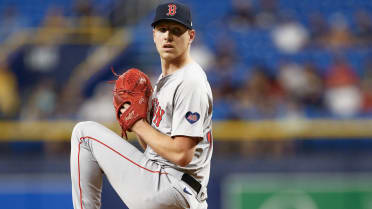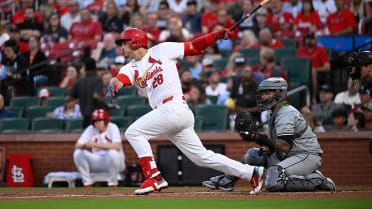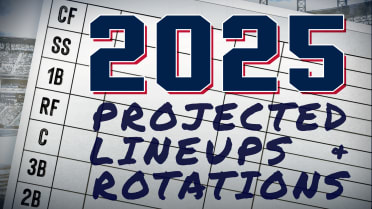The Hall of Famer who broke into the bigs at 17
A lot of the great ones start early. Many of baseball's most iconic Hall of Famers, from Mickey Mantle to Ken Griffey Jr., have played the first games of their careers as teenagers.
And Mel Ott started the earliest of all.
Ott had just turned 17 when he made his Major League debut for the New York Giants on April 27, 1926. Born on March 2, 1909, he wasn't even two months past his 17th birthday.
That day, with the Giants facing the Phillies at the Baker Bowl, Ott struck out as a pinch-hitter in his only at-bat. But that was the beginning of a 22-year MLB career in which Ott became one of the greatest right fielders of all time. He amassed 511 home runs, 2,876 hits and a .304 lifetime batting average for New York, was a 12-time All-Star and won the 1933 World Series.
Ott is one of five Hall of Famers to make his AL/NL debut at the age of 17. Jimmie Foxx, Bob Feller, Amos Rusie and Harmon Killebrew did, too. But Ott was the youngest.
Youngest Hall of Famers to make AL/NL debut
Mel Ott -- 17 years, 56 days
Jimmie Foxx -- 17 years, 191 days
Bob Feller -- 17 years, 259 days
Amos Rusie -- 17 years, 344 days
Harmon Killebrew -- 17 years, 359 days
Here's the story of how it happened.
Ott was 16 years old and playing catcher for a semi-pro lumber company team in Patterson, La., when he got his big break: a tryout with legendary Giants manager John McGraw.
Ott had been denied a spot on his local Minor League team, the New Orleans Pelicans of the Southern Association -- whose alumni include Dazzy Vance, Joe Sewell, Bob Lemon, Earl Weaver and Shoeless Joe Jackson -- because he was too small. (Ott, even as a Major Leaguer, stood 5-foot-9 and 170 pounds.)
But he became such a star for the lumber team that the company's owner, Henry Williams, recommended Ott to McGraw for a tryout during a trip to New York. Williams bought Ott a train ticket to the big city and, in September 1925, Ott arrived to try out for the Giants.
The young Ott made an immediate impression.
As Ott biographer Fred Stein chronicles, Hall of Fame second baseman Frankie Frisch attentively watched Ott take batting practice. He took notice of how Ott first sprayed the ball through the infield, then drove several pitches off the advertising signs on the right-field wall.
But it was McGraw who immediately saw something special in Ott.
"He's got the most natural swing I’ve seen in years," McGraw told a reporter at the tryout. "This lad is going to be one of the greatest left-handed hitters the National League has seen."
McGraw knew the Giants had to have Ott. In January 1926, he gave the still-16-year-old a contract and a $400 bonus.
Ott was moved from catcher to the outfield because of his size, and he learned the position from the best: McGraw, Giants Hall of Fame right fielder Ross Youngs and coach Roger Bresnahan -- himself a Hall of Fame catcher and outfielder.
McGraw didn't want to send Ott off to a Minor League team when he could oversee Ott's development himself. So he kept Ott with the big league club.
Two weeks into the 1926 season, Ott -- who had turned 17 a little over a month before Opening Day -- got into a game for the first time.
Ott's MLB debut wasn't the most memorable, but he quickly proved McGraw to be prescient.
He notched his first career hit a few days later at the Polo Grounds and went on to bat .383 in 35 games in his first season.
Ott didn't hit his first home run until the next year, at the ripe age of 18, an inside-the-parker against the Cubs in New York. There would be plenty more after that.
After two seasons being groomed as an outfielder, the still-19-year-old Ott took over as the Giants' full-time right fielder in 1928 -- and put together one of the top seasons ever by a teenager. But the next year was his true breakout: Ott batted .328 with 42 homers and 151 RBIs at age 20 in 1929.
Over the next two decades, Ott did indeed become one of the greatest left-handed hitters the National League has ever seen … and Major League Baseball has ever seen.
Ott's 5-foot-9 stature didn't stop him from leading the league in home runs six times, or from becoming the third member of the 500-home-run club alongside Babe Ruth and Foxx in 1945, his 20th season in the big leagues.
And in 1951, the fourth year after his retirement, Ott was elected to the Baseball Hall of Fame with 87.2% of the vote, completing the legendary career arc that began 25 years earlier, as a 17-year-old lefty that the Giants knew would be their next great hitter.
David Adler is a reporter for MLB.com based in New York.




